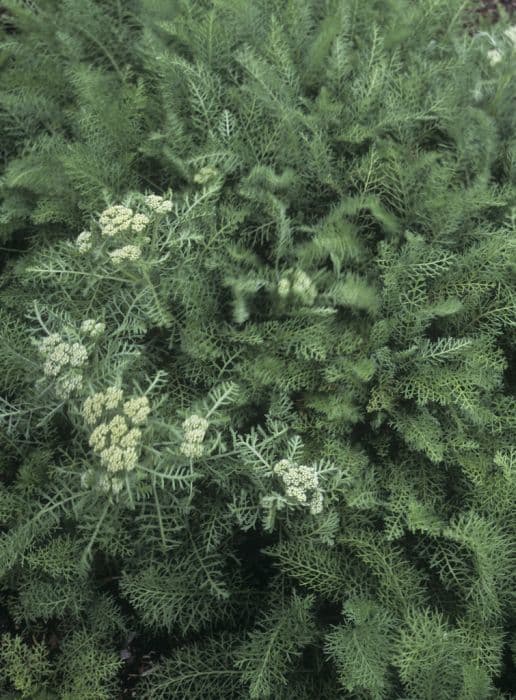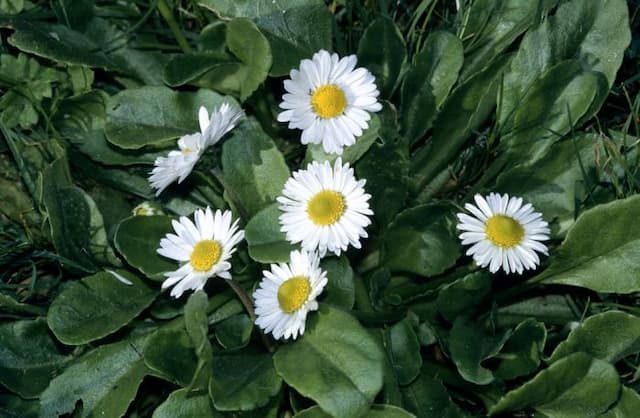Salmon Beauty Yarrow Achillea 'Lachsschönheit' (Galaxy Series)

ABOUT
The Achillea 'Lachsschönheit', also known as Salmon Beauty, is part of the Galaxy Series and showcases a captivating display of colors and textures. This plant features a plume of vibrant, salmon-pink flower heads that create a stunning visual impact. The flowers are densely packed in flat-topped clusters that sit proudly above the foliage, offering a showy and colorful appeal throughout its bloom time. The leaves of the Salmon Beauty are equally striking, with a fern-like appearance that provides a delicate and intricate backdrop for the bold flowers. These leaves are often a soft green shade and are finely dissected, resembling delicate lace. Together, the contrast between the frothy green foliage and the warm salmon-pink blossoms give this plant a distinctive and attractive look that draws the eye in garden settings. As a perennial, this plant returns year after year, with the foliage emerging in early spring followed by the flowers blooming in the warmer months. Its overall growth habit forms a neat, mounded clump that neatly complements other plants in a garden bed or border. The Achillea 'Lachsschönheit' is not only aesthetically pleasing but also attracts a range of beneficial wildlife, including butterflies and bees, which find the flower clusters an excellent source of nectar.
About this plant
 Names
NamesFamily
Asteraceae
Synonyms
Salmon Beauty Yarrow, Galaxy Hybrid Yarrow
Common names
Achillea 'Lachsschönheit'
 Toxicity
ToxicityTo humans
Yarrow (Achillea 'Lachsschönheit' from the Galaxy Series) is not generally considered toxic to humans. In fact, yarrow has a long history of use in herbal medicine for various applications. However, like any plant, there might be instances of individuals who are sensitive or allergic to yarrow, potentially leading to skin irritation when touched or digestive discomfort if ingested in large quantities. It is important to use caution and possibly seek guidance from a professional herbalist or a medical practitioner if considering yarrow for medicinal use, especially since excessive consumption can lead to adverse effects.
To pets
Yarrow is also known to have a mild level of toxicity to pets such as dogs and cats. While it is not typically considered deadly, ingestion of this plant may result in gastrointestinal upset for your pet, which might manifest as vomiting or diarrhea. If you suspect your pet has consumed a large amount of yarrow, it's advisable to monitor them closely and consult with a veterinarian if any adverse symptoms arise or persist.
 Characteristics
CharacteristicsLife cycle
Perennials
Foliage type
Deciduous
Color of leaves
Green
Flower color
Salmon
Height
2-3 feet (0.6-0.9 meters)
Spread
2-3 feet (0.6-0.9 meters)
Plant type
Herb
Hardiness zones
3-8
Native area
Europe
Benefits
 General Benefits
General Benefits- Attracts Pollinators: Yarrow is known for attracting bees and butterflies, which can aid in the pollination of surrounding plants.
- Drought Tolerant: Once established, it is very drought resistant, requiring minimal watering and care.
- Low Maintenance: It requires little upkeep other than occasional deadheading to promote more blooms.
- Long Blooming: Yarrow has a long blooming season, providing color in the garden from early summer to early fall.
- Deer Resistant: Its aromatic foliage makes it less appealing to deer, making it a good choice for areas with deer pressure.
- Attractive Foliage: The fern-like foliage is aesthetically pleasing even when the plant is not in bloom.
- Versatile Landscaping: It can be used in borders, rock gardens, and as groundcover.
- Tolerates Poor Soil: Yarrow can thrive in less than ideal soil conditions, including poor, dry, or rocky soils.
- Provides Cut Flowers: The flowers of yarrow make excellent additions to fresh or dried floral arrangements.
- Soil Erosion Control: Its spreading habit and robust root system can help to prevent soil erosion.
 Medical Properties
Medical Properties- Anti-inflammatory: Common yarrow contains compounds that may reduce inflammation in the body.
- Astringent: It can be used topically to help tighten the skin and reduce bleeding from minor injuries due to its astringent properties.
- Carminative: Yarrow is traditionally used to help relieve digestive issues, such as reducing gas and bloating.
- Antispasmodic: The plant is said to have antispasmodic effects, which may help alleviate cramps and spasms.
- Diaphoretic: Yarrow has been used to induce sweating, which can be beneficial in reducing fevers.
- Hemostatic: It has been used to stop bleeding both internally and externally.
- Antiseptic: Yarrow possesses antiseptic properties, making it useful for cleaning wounds and preventing infections.
 Air-purifying Qualities
Air-purifying QualitiesThis plant is not specifically known for air purifying qualities.
 Other Uses
Other Uses- Companion Planting: Yarrow can be used among vegetables like tomatoes to enhance growth and flavor.
- Natural Dye: The flowers of yarrow can be used to produce a yellow or green dye for coloring fabrics.
- Aquatic Plant Filter: Yarrow can be planted around small garden ponds to help filter and absorb excess nutrients.
- Erosion Control: The plant's extensive root system can help to stabilize soil and prevent erosion.
- Soil Health Indicator: Yarrow's presence can indicate a well-balanced soil rich in key nutrients.
- Biodynamic Preparations: Used in biodynamic agriculture to make compost preparations that benefit soil quality and plant health.
- Crafts: Dried yarrow flowers can be used in flower arrangements, wreaths, and potpourri for their shape and subtle color.
- Photographic Subject: Yarrow's unique cluster of flowers make it an interesting subject for botanical photographers.
- Livestock Feed: It can be included in the diet of certain livestock like sheep in small amounts to provide variety.
- Garden Design: Yarrow's feathery foliage and colorful blooms are used to add texture and depth in landscape planning.
Interesting Facts
 Feng Shui
Feng ShuiThe Yarrow is not used in Feng Shui practice.
 Zodiac Sign Compitability
Zodiac Sign CompitabilityThe Yarrow is not used in astrology practice.
 Plant Symbolism
Plant Symbolism- Healing: Achillea, commonly known as Yarrow, is named after the Greek hero Achilles who purportedly used it to treat his soldiers' wounds during the Trojan War. Therefore, it symbolizes healing both physically and emotionally.
- Protection: In ancient traditions, Yarrow was thought to ward off negative energies and provide protection, making it a symbol for safeguarding against harm.
- Love Divination: Yarrow has a history of use in rituals for divining the future of romantic relationships, symbolizing the quest for love insight.
- Courage: Reflective of its ties to Achilles, the plant is also emblematic of bravery and the courage to face challenges.
- Persistence: Yarrow is known for its hardiness and ability to thrive in challenging conditions, symbolizing perseverance and endurance.
 Water
WaterThe Salmon Beauty Yarrow should be watered deeply but not too frequently, allowing the soil to dry out between waterings to avoid waterlogging. Typically, providing about one inch of water per week, depending on the weather and soil conditions, will suffice. It's preferable to use a soak method, watering at the base of the plant, to avoid wetting the foliage which can lead to fungal diseases. In the peak of summer, you may need to water twice a week if conditions are very dry. Cut back on watering as the plant goes dormant in the fall and winter.
 Light
LightSalmon Beauty Yarrow thrives in full sun and will perform best when it receives at least 6 hours of direct sunlight daily. A spot that offers bright, direct light will ensure prolific flowering and strong growth. Partial shade is tolerable, especially in hot climates, however, too much shade can lead to leggy plants and poor blooming.
 Temperature
TemperatureSalmon Beauty Yarrow is a hardy plant, enduring temperatures as low as 20 degrees Fahrenheit and as high as 85 degrees Fahrenheit. The ideal growing temperature range is between 65 to 75 degrees Fahrenheit. It is important to protect the plant from extreme cold with mulch or coverings if temperatures are expected to drop below 20 degrees Fahrenheit.
 Pruning
PruningPruning Salmon Beauty Yarrow is essential to promote vigorous growth and prolong the blooming period. Deadhead spent flowers regularly to encourage a second bloom. Perform a more thorough pruning by cutting back to about a third of the plant's size after the first flowering cycle to rejuvenate and prepare it for another round of blooms. Pruning should be done in late summer or early fall, after the blooming has finished.
 Cleaning
CleaningAs needed
 Soil
SoilYarrow 'Lachsschönheit' prefers well-draining soil with a pH range of 5.5 to 7.0. A mix of garden soil, compost, and a bit of sand or perlite to improve drainage is ideal.
 Repotting
RepottingYarrow 'Lachsschönheit' does not typically require repotting as it is usually grown outdoors and can spread naturally.
 Humidity & Misting
Humidity & MistingYarrow 'Lachsschönheit' is tolerant of a wide range of humidity conditions and does well in average garden humidity levels.
 Suitable locations
Suitable locationsIndoor
Grow in a sunny spot with well-draining soil and minimal water.
Outdoor
Full sun, well-draining soil, and moderate watering.
Hardiness zone
3-8 USDA
 Life cycle
Life cycleAchillea 'Lachsschönheit', commonly known as Yarrow from the Galaxy Series, typically starts its life as a dormant seed, which germinates in late winter to early spring when conditions are favorable with adequate moisture and temperature. Upon germination, the seedling emerges and develops into a young plant with characteristic feathery foliage. As the plant matures, it forms a clump of leaves at ground level, from which flower stalks arise during late spring to summer, culminating in a display of salmon-pink flower heads that attract a wide range of pollinators. After flowering, the plant sets seeds which can be dispersed by wind or wildlife, and as a perennial, its foliage may die back in fall to winter, depending on the climate, while the root system remains alive. During winter, the plant remains dormant, reinvigorating and beginning a new cycle of growth with the return of warmer temperatures in the following spring. Yarrow is also capable of vegetative reproduction; it can spread through rhizomes, creating new clumps nearby the parent plant and expanding its presence in a garden or landscape.
 Propogation
PropogationPropogation time
Spring to Early Summer
The most popular method of propagating the Common Yarrow, specifically the Achillea 'Lachsschönheit' (Galaxy Series), is through division. This is typically done in the spring or fall when the plant's growth is not at its peak. To propagate by division, carefully dig around the plant and lift it from the ground, making sure to keep a generous amount of soil around the roots. Using a sharp spade or knife, divide the plant into smaller sections, each with a portion of the root system and shoots. These divisions can then be replanted immediately into well-prepared soil, spaced about 1 to 2 feet apart (approximately 30 to 60 centimeters) to allow adequate room for growth. Water the new plants thoroughly after planting to help establish them. Division helps to rejuvenate older clumps of yarrow by improving their vigor and flowering.









